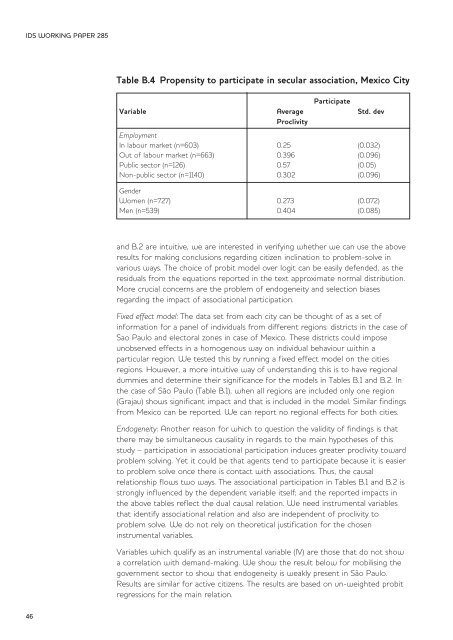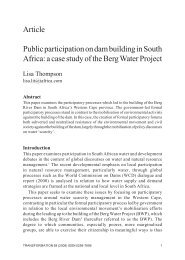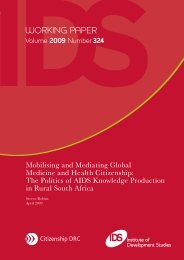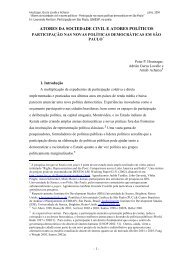Associations and the Exercise of Democratic ... - Citizenship DRC
Associations and the Exercise of Democratic ... - Citizenship DRC
Associations and the Exercise of Democratic ... - Citizenship DRC
You also want an ePaper? Increase the reach of your titles
YUMPU automatically turns print PDFs into web optimized ePapers that Google loves.
IDS WORKING PAPER 285Table B.4 Propensity to participate in secular association, Mexico CityParticipateVariable Average Std. devProclivityEmploymentIn labour market (n=603) 0.25 (0.032)Out <strong>of</strong> labour market (n=663) 0.396 (0.096)Public sector (n=126) 0.57 (0.05)Non-public sector (n=1140) 0.302 (0.096)GenderWomen (n=727) 0.273 (0.072)Men (n=539) 0.404 (0.085)<strong>and</strong> B.2 are intuitive, we are interested in verifying whe<strong>the</strong>r we can use <strong>the</strong> aboveresults for making conclusions regarding citizen inclination to problem-solve invarious ways. The choice <strong>of</strong> probit model over logit can be easily defended, as <strong>the</strong>residuals from <strong>the</strong> equations reported in <strong>the</strong> text approximate normal distribution.More crucial concerns are <strong>the</strong> problem <strong>of</strong> endogeneity <strong>and</strong> selection biasesregarding <strong>the</strong> impact <strong>of</strong> associational participation.Fixed effect model: The data set from each city can be thought <strong>of</strong> as a set <strong>of</strong>information for a panel <strong>of</strong> individuals from different regions: districts in <strong>the</strong> case <strong>of</strong>Sao Paulo <strong>and</strong> electoral zones in case <strong>of</strong> Mexico. These districts could imposeunobserved effects in a homogenous way on individual behaviour within aparticular region. We tested this by running a fixed effect model on <strong>the</strong> citiesregions. However, a more intuitive way <strong>of</strong> underst<strong>and</strong>ing this is to have regionaldummies <strong>and</strong> determine <strong>the</strong>ir significance for <strong>the</strong> models in Tables B.1 <strong>and</strong> B.2. In<strong>the</strong> case <strong>of</strong> São Paulo (Table B.1), when all regions are included only one region(Grajau) shows significant impact <strong>and</strong> that is included in <strong>the</strong> model. Similar findingsfrom Mexico can be reported. We can report no regional effects for both cities.Endogeneity: Ano<strong>the</strong>r reason for which to question <strong>the</strong> validity <strong>of</strong> findings is that<strong>the</strong>re may be simultaneous causality in regards to <strong>the</strong> main hypo<strong>the</strong>ses <strong>of</strong> thisstudy – participation in associational participation induces greater proclivity towardproblem solving. Yet it could be that agents tend to participate because it is easierto problem solve once <strong>the</strong>re is contact with associations. Thus, <strong>the</strong> causalrelationship flows two ways. The associational participation in Tables B.1 <strong>and</strong> B.2 isstrongly influenced by <strong>the</strong> dependent variable itself; <strong>and</strong> <strong>the</strong> reported impacts in<strong>the</strong> above tables reflect <strong>the</strong> dual causal relation. We need instrumental variablesthat identify associational relation <strong>and</strong> also are independent <strong>of</strong> proclivity toproblem solve. We do not rely on <strong>the</strong>oretical justification for <strong>the</strong> choseninstrumental variables.Variables which qualify as an instrumental variable (IV) are those that do not showa correlation with dem<strong>and</strong>-making. We show <strong>the</strong> result below for mobilising <strong>the</strong>government sector to show that endogeneity is weakly present in São Paulo.Results are similar for active citizens. The results are based on un-weighted probitregressions for <strong>the</strong> main relation.46





